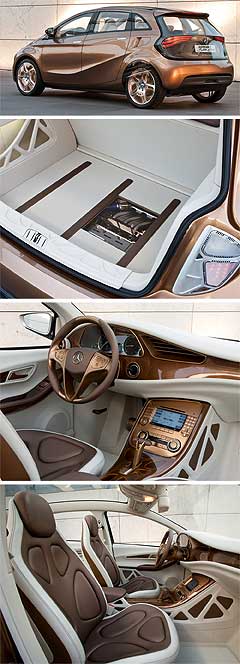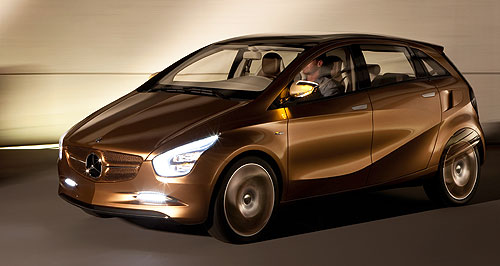Make / Model Search
Future models - Mercedes-Benz - B-Class - BlueZERO E-Cell PlusFirst look: Benz reveals Volt-beating plug-in hybridSmart car: The Mercedes E-Cell Plus hybrid will use a three-cylinder Smart engine to generate range-extending electricity. Mercedes expands future E-Cell electric car series with a plug-in hybrid3 Sep 2009 By TERRY MARTIN MERCEDES-BENZ will unveil an all-new plug-in electric hybrid car dubbed the E-Cell Plus at the Frankfurt motor show on September 15 ahead of a limited production run in 2010. After last week announcing that its B-class-based F-Cell hydrogen-electric hybrid would soon hit the road in Europe and the US – as the world’s first series-production fuel-cell vehicle – the German manufacturer has now revealed that it is close to market with a range-extending hybrid that will rival the Chevrolet Volt and a range of small eco cars from BMW, Audi and Lexus. Both the E- and F-Cell come under Mercedes-Benz’s BlueZero sub-brand and were shown as concepts at the North American International Auto Show in January. Since then, however, Mercedes has split the E-Cell into two model variants. It is continuing with the all-electric E-Cell as shown in Detroit – which, based on the show car, offers 100kW/320Nm and a range of up to 200km – but with the E-Cell Plus has added a small petrol engine to the powertrain package. As is the case with General Motors’ Volt, the E-Cell Plus relies predominantly on battery power and uses the internal combustion engine – in this case a Smart-derived 1.0-litre three-cylinder turbo producing 50kW at 3500rpm – to recharge its lithium-ion batteries and extend its range.  Mercedes claims the vehicle can travel up to 100km in zero-emissions electric mode, with a total range of up to 600km – a considerable distance further than the Volt, which in its current pre-production form, with a 1.4-litre four-cylinder engine, manages 40 all-electric miles (64km) and an overall range of around 300 miles (483km). Mercedes claims the vehicle can travel up to 100km in zero-emissions electric mode, with a total range of up to 600km – a considerable distance further than the Volt, which in its current pre-production form, with a 1.4-litre four-cylinder engine, manages 40 all-electric miles (64km) and an overall range of around 300 miles (483km).As with the other two BlueZero cars, the E-Cell Plus is based on Mercedes’ front-drive A- and B-class sandwich-floor platform architecture which houses the same 17.5kW/h liquid-cooled lithium-ion batteries and a compact electric motor offering 100kW (with a sustained output of 70kW). The petrol engine is also installed in the area of the rear axle. The plug-in hybrid is claimed to have enough power accelerate from 0-100km/h in less than 11 seconds, on its way to an electronically governed top speed of 150km/h. No fuel consumption figure has been published – unlike GM, which claims 1.2L/100km for the Volt (based on a draft US EPA standard) – but Mercedes does claim that the E-Cell Plus will have a CO2 emissions rating of just 32g/km. According to Benz, the recharging time using a conventional household outlet is six hours, with rapid charging for 30 minutes providing a 50km cruising range. The full electric range of 100km requires a charging time of about an hour. Pointing to the next-generation B-class due for release in 2011/12, the BlueZero trio share fundamental technological components and have identical designs and vehicle dimensions (including 4220mm in overall length). While the sandwich-floor construction enables the eco drivetrains to be installed in a way that they take up little space, ensure a good centre of gravity and are fully protected, the platform also provides the basis for a compact exterior and spacious and versatile cabin. But it will not be the sole small-car platform from Mercedes, with the German marque confirming this week that a more conventional platform is also under development that will enable it to produce a sportier, more appealing (and cheaper) compact series akin to the BMW 1 Series. “The improved sandwich-floor platform serves as the perfect basis for a diverse range of vehicles with electric drives,” said Mercedes-Benz Cars group R&D chief Thomas Weber. “We are currently developing an additional platform for future compact models that have drive systems using optimised internal combustion engines. The smart linking of both architectures will allow us to expand our product range in an extremely flexible and efficient manner. “Beginning in 2009, we will manufacture the first small batch of Mercedes fuel cell cars. In 2010, they will be followed by a small batch of Mercedes-Benz vehicles that run solely on electric power supplied by a battery. Thanks to these measures, we are excellently positioned for the future.” In releasing its latest eco-car details, Mercedes has again emphasised that the “unrestricted and convenient operation of electric cars still faces a series of challenges, including high system costs, insufficient infrastructure and short cruising ranges”. It said advanced diesel and petrol engines “will remain the driving force for automobiles for a long time to come” in both passenger cars and commercial vehicles, and that it will not be replacing vehicles with combustion engines “any time soon”. “BlueZero offers a triple demonstration of the technical maturity of alternative drive systems from Mercedes-Benz,” said Daimler’s head of E-Drive and chief environmental officer Herbert Kohler. “(But) electric vehicles with battery electric or fuel-cell drive systems will not truly be on an equal footing with today’s combustion engine drive systems until the customers are confident that there is a sufficient infrastructure of electricity and hydrogen refuelling stations.”  Read more31st of August 2009  Mercedes fuel-cell B-class to hit US, Euro marketsBenz B-class F-Cell hydrogen-electric hybrid offers hot performance, zero emissionsAll motor show Alfa Romeo Alfa Romeo Abarth Abarth Alpine Alpine Alpina Alpina Audi Audi Aston Martin Aston Martin BMW BMW Bentley Bentley Chery Chery Brabham Brabham Chrysler Chrysler Chevrolet Chevrolet Cupra Cupra Citroen Citroen DS DS Dodge Dodge Fiat Fiat Ferrari Ferrari Foton Foton Ford Ford Great Wall Great Wall FPV FPV Haval Haval GWM GWM Honda Honda Holden Holden Hummer Hummer HSV HSV Infiniti Infiniti Hyundai Hyundai Jaguar Jaguar Isuzu Isuzu Kia Kia Jeep Jeep Land Rover Land Rover Lamborghini Lamborghini Lexus Lexus LDV LDV Mahindra Mahindra Lotus Lotus Mazda Mazda Maserati Maserati Mercedes-AMG Mercedes-AMG McLaren McLaren MG MG Mercedes-Benz Mercedes-Benz Mitsubishi Mitsubishi Mini Mini Opel Opel Nissan Nissan Peugeot Peugeot Pagani Pagani Proton Proton Porsche Porsche Renault Renault Ram Ram Rover Rover Rolls-Royce Rolls-Royce Skoda Skoda Saab Saab SsangYong SsangYong Smart Smart Suzuki Suzuki Subaru Subaru Toyota Toyota Tesla Tesla Volvo VolvoMotor industry news |
Click to shareAll motor show Alfa Romeo Alfa Romeo Abarth Abarth Alpine Alpine Alpina Alpina Audi Audi Aston Martin Aston Martin BMW BMW Bentley Bentley Chery Chery Brabham Brabham Chrysler Chrysler Chevrolet Chevrolet Cupra Cupra Citroen Citroen DS DS Dodge Dodge Fiat Fiat Ferrari Ferrari Foton Foton Ford Ford Great Wall Great Wall FPV FPV Haval Haval GWM GWM Honda Honda Holden Holden Hummer Hummer HSV HSV Infiniti Infiniti Hyundai Hyundai Jaguar Jaguar Isuzu Isuzu Kia Kia Jeep Jeep Land Rover Land Rover Lamborghini Lamborghini Lexus Lexus LDV LDV Mahindra Mahindra Lotus Lotus Mazda Mazda Maserati Maserati Mercedes-AMG Mercedes-AMG McLaren McLaren MG MG Mercedes-Benz Mercedes-Benz Mitsubishi Mitsubishi Mini Mini Opel Opel Nissan Nissan Peugeot Peugeot Pagani Pagani Proton Proton Porsche Porsche Renault Renault Ram Ram Rover Rover Rolls-Royce Rolls-Royce Skoda Skoda Saab Saab SsangYong SsangYong Smart Smart Suzuki Suzuki Subaru Subaru Toyota Toyota Tesla Tesla Volvo VolvoMotor industry news |











Facebook Twitter Instagram